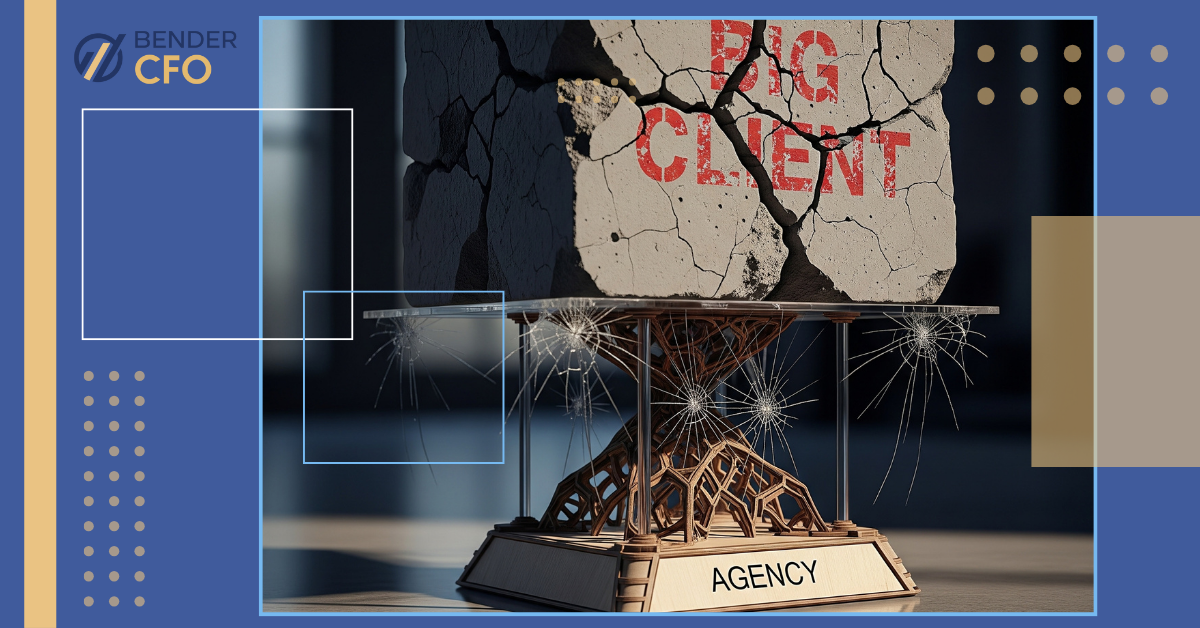How CFOs are Integral to Helping Small Business be Successful
Since I started my CFO Services Firm, it seems like small businesses have had to endure challenges...
By: Shane Bender on Aug 7, 2025 4:20:10 PM

If one client walked away tomorrow, how long could your agency survive?
It’s a scenario most agency owners don’t want to think about—but it’s one you can’t afford to ignore. Relying too heavily on a single client for your revenue exposes your business to client concentration risk. It’s one of the most common—and most dangerous—financial blind spots in the agency world.
Want to know how to protect yourself? Watch this quick video, then keep reading for actionable steps.
📽️ Watch: How to protect your agency from client concentration risk
Client concentration risk happens when a single client accounts for a significant portion of your total revenue—often 20%, 50%, or even more. It’s a threat that can quietly undermine everything your agency has built.
A real-world example: one company built its entire business on a single client that made up 75% of their revenue. At first, the relationship worked. But the finance team lived in constant anxiety—forecasting worst-case cash scenarios, building spreadsheets around “how long could we last if they left,” and hoping it wouldn’t happen.
Eventually, the client did leave. Fortunately, by that point, their revenue share had dropped to just 12% thanks to intentional growth and diversification. That proactive shift saved the business.
When you land a large client, it can feel like the answer to all your problems. But that stability is often an illusion—especially for agencies.
Large clients often appear more profitable because of economies of scale. Processes are dialed in. Communication flows faster. Work feels easier. But they can also:
If that one big client leaves, you’re not just losing revenue—you’re losing the profit that supports everything else. Downsizing won’t be enough. You may have to cut deeply and rapidly to stay alive
Let’s be honest: when a big opportunity lands in your inbox, you’re probably going to say yes. And in most cases, you should—if you’re prepared.
If a client offers to double your revenue overnight, and your team can handle it, saying yes makes sense. But you also need to be realistic: when a single client crosses the 50% mark, you’re no longer running an agency—you’re managing a single-account dependency.
That’s why having a financial cushion, a line of credit, and a well-modeled scenario plan is essential. It’s not about saying no—it’s about saying yes without putting your entire agency at risk
You don’t have to turn down big opportunities—but you do need a plan to balance growth with stability. Here’s how to build that plan.
Start setting aside a portion of that client’s revenue immediately.
Aim to save six months of operating expenses, just like a personal emergency fund. If that feels like too much, start with three—but start now.
Run scenario models like:
This kind of proactive modeling isn’t pessimism—it’s preparation.
Get a credit line in place now—while your financials are strong. If a major client exits and cash gets tight, a pre-approved credit facility can buy you the time needed to pivot without panic.
Agency relationships don’t last forever. Many clients stay for just 2–3 years. If you’re in year two, start preparing for what happens when that client moves on.
Check how long they worked with their previous agency. Use that as a baseline to determine how aggressive your cash-saving strategy needs to be.
In 1900, the city of Galveston, Texas was leveled by a hurricane that killed over 8,000 people. The tragedy wasn’t just the storm—it was the lack of preparation. Prior storms had hit nearby areas. Warnings were ignored. Smaller towns had even abandoned their locations entirely after earlier disasters. Yet no one in Galveston seriously planned for a worst-case scenario.
That kind of complacency is what puts agencies at risk today.
Just like a city needs a disaster plan, your agency needs a financial one. Losing a major client is your hurricane. Planning now means surviving later.
No one’s telling you to turn down good business. But if you say yes to a client that makes up half your revenue, you need to start preparing for life after them—from day one.
Smart agencies don’t gamble. They plan. And that planning starts with financial visibility and leadership.
Client concentration isn’t just a risk—it’s a roadblock to scalability. If your entire business model depends on one client, you’re not growing. You’re just coasting.
At Bender CFO Services, we help agencies:
You don’t need a full-time CFO to get this kind of clarity. But you do need more than just a bookkeeper.
Since I started my CFO Services Firm, it seems like small businesses have had to endure challenges...
In the dynamic business environment of 2024, small and medium-sized businesses (SMBs) encounter...
As a business owner, it's crucial to be prepared for a potential downturn in the economy. The past...